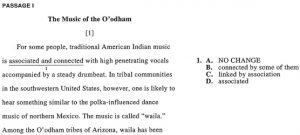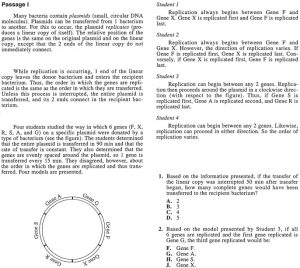
ACT Exam Guide: All About the ACT
Welcome to the second part of MEK’s Exam Guide series, where we are providing a detailed view of all the major exams we offer to give you a better understanding of each test’s components, scoring system, and to better set your expectations. This article will focus on the ACT, one of the standardized testing options students can choose for their college application.
General ACT Information
The ACT is an alternative to the SAT during the college application process. The test functions similarly to the SAT by measuring a student’s learning abilities and competencies to gauge their readiness for higher education. Although some universities have removed the requirement for students to submit their ACT scores during their application, the inclusion of this test can still help students stand out from the crowd by further proving their college-readiness.
The Structure of the ACT
The ACT differs from the SAT in a few major ways, one of which being the different topics the student is tested on. Rather than having three test topics like the SAT, the ACT has four sections and an optional written essay. Each section has a different amount of time allotted to answer a varying number of questions, along with different question types for each.
- English – 45 minutes, 75 multiple choice questions
- Math – 60 minutes, 60 multiple choice questions
- Reading – 35 minutes, 40 multiple choice questions
- Science – 35 minutes, 40 multiple choice questions
- Optional Essay – 40 minutes, 1 essay prompt
Each of these sections is of course slightly different in structure, the specifics of which we will cover a little later in the article. One of the key differences to notice right away though is that the time provided for each of the ACT sections is relatively short, requiring students to manage time pressure significantly more than with the SAT.
How the ACT is Scored
When it comes to the ACT, the score range is quite different from the SAT. Instead of being out of 1600, the composite is out of 36. In order to find this final score, each section’s raw score is taken as the number of questions they got right compared to the number they got wrong. Next, in order to compensate for the varying difficulty level of different questions on different tests, these raw scores are then scaled to create scale scores. These scale scores enable a fair comparison of different students that took different test forms, and thus are the scores that colleges and scholarships are sent. The average of these four scale scores then becomes the examinee’s composite score.
The Differences Between Each ACT Section
Now, we’ll take a closer look at each of the sections within the ACT, understanding the differences in structure as well as providing some examples of questions from each part.
The English Section
The English section includes several essays or passages, each followed by a set of multiple-choice questions. Some questions will refer to underlined portions of the passage and ask you to determine whether provided alternatives or the given text is the most appropriate within the context of the passage. There are also questions regarding a specific section of the passage and students must choose the best answer to the posted question.
These questions are intended to place students in the position of a writer trying to make decisions while revising and editing their text. The pieces can cover a variety of genres and present a diverse selection of situations to test students’ written abilities.
Within the English section, there are three underlying categories that students are tested on through varying types of questions and focuses. Each of these categories makes up an approximate percentage of the section. The following table gives you a better idea of these categories and their makeup within the section.
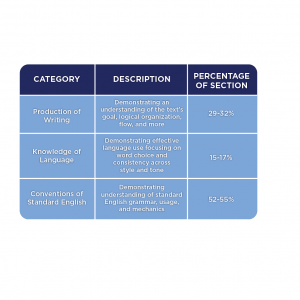
The following is an example of what an English passage might look like, along with an example question.
The Math Section
Now, when it comes to the Math section of the ACT, one major difference with the SAT is that students are allowed to use an approved calculator for the entire section. There is NO part of the ACT Math section that doesn’t allow for the use of a calculator.
Similarly to the English section, the Math section also has a number of different question categories taking up different amounts of the overall section. The following table covers each of the eight categories within the section.
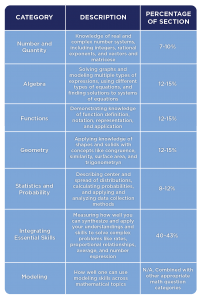
The following is an example of what a few math questions might look like from this section.
The Reading Section
The next section is Reading, focusing on student ability to read closely and reason logically about texts. Passages come with background information that could be important for the reader’s understanding. There are three categories of questions that test for more advanced comprehension concepts. The following table covers each of the question categories along with their associated make up of the section.
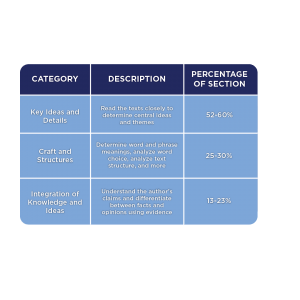
On some tests, one of the passages might include a graph or table that contains relevant information. There could be a question asking specifically about the information from the graphic in order to determine the answer.
The following is an example of a Reading passage and an associated question.
The Science Section
The final portion is the Science section and is exclusive to the ACT. The Science section doesn’t require routine memorization of science facts, but rather consists more of interpreting, analyzing, and evaluating information provided within several authentic scientific scenarios. While some basic knowledge of areas such as biology, chemistry and Earth sciences is expected, no advanced knowledge is required.
Similar to each of the other sections, there are varying types of questions asked within the Science section. The following table covers each of the three categories and their associated make-up of the section.
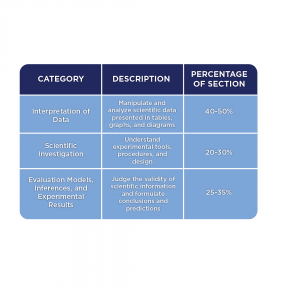
In addition to the different question types, the Science section also presents information in three different formats as well. The following table provides more information on these information types and their frequency of occurrence.

The following are some examples of these different information types along with some examples of associated questions.
How Can You Begin to Prepare for the ACT
After learning more about the ACT, the next step is to determine whether this is the right test for you. As previously stated, both the ACT and the SAT can work in the college application process. Both tests offer their own unique benefits and drawbacks, so if you’d like to learn more about the SAT please check out our first part of the exam guide series here!
However, if you’ve decided that the ACT is the right test to take, MEK recently created a program called ACT Connect.
ACT Connect is a self paced, online program great for motivated, self starters who thrive in a virtual setting. The course provides quality teaching along with newfound flexibility and convenience through individual modules and unique package options. If you’d like to hear more about the ACT Connect program, please check it out here!
For students needing more guidance, we also offer ACT Private Test Prep Tutoring both in-person and virtually. You’ll receive the one-on-one support and personalized ACT Prep materials and timeline to get you to your goal.
If you have any questions or concerns, give us a call at +1 (855) 346-1410 or contact us today. If you’d like to speak more about ACT Connect specifically, please send us an email at connect@mekreview.com!


